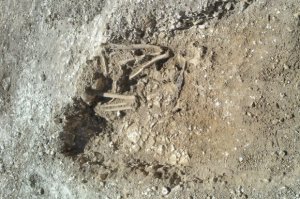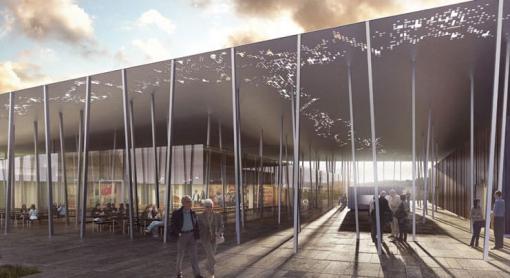Archaeologists have discovered six Pagan Saxon skeletons dating back over 1,000 years on a housing development site just a few miles from Stonehenge.
The discoveries, which also include round barrows dating back to the Bronze Age 4,000 years ago, were unearthed at a redundant brownfield development site in Amesbury, Wiltshire, which is also famous for the Amesbury Archer – an early Bronze Age man found buried among arrowheads.
The remains are thought to be those of adolescent to mature males and females. Five skeletons were arrayed around a small circular ditch, with the grave of a sixth skeleton in the centre. Two lots of beads, a shale bracelet and other grave goods were also found, which suggest the findings are Pagan.
The site is now being excavated for other artefacts by Wessex Archaeology, led by Phil Harding, known for his work on Channel 4’s Time Team, while colleagues back at the unit’s laboratory examine the remains and jewellery, which have already been removed.
Phil said: “Given that the Stonehenge area is a well-known prehistoric burial site, it was always very likely some interesting discoveries would be made here. The fact that these round barrows were previously unknown makes this particularly exciting.
“Finding the skeletons also helps us to get a clearer picture of the history of this area. To my knowledge these are the first Pagan Saxon burials to be excavated scientifically in Amesbury. “
Landowner Aster Group is building 14 affordable homes at the redundant brownfield site, which will be available to rent from 2014.
Anna Kear, Aster’s regional development director for Hampshire and Wiltshire, said: “Wiltshire is a treasure trove of archaeology, drawing people from across the world.
“Discovering a burial site in this beautiful county is always a possibility when building affordable homes. We’re working with everyone involved to ensure Phil and his team can investigate this exciting find while the build continues.”
Contractor Mansell, a Balfour Beatty brand, was preparing the site for the build when it made the discovery.
Site manager Brian Whitchurch-Bennett, of Mansell, said: “When we’re working in an area of historical importance we always undertake archaeological investigations to make sure that our construction works don’t damage hidden remains or artefacts. The findings within this particular site really are a one off, we’ve been amazed by the number of discoveries and the level of preservation. It’s certainly a project to remember.”
The archaeologists are expected to be on site for six weeks in total. Footage from the site may also be included in an archaeological production for ITV’s History Channel, due to be aired in January 2014.
Source: Published by Jon Land for 24dash.com: http://www.24dash.com/news/housing/2013-05-17-Archaeologists-uncover-Pagan-skeletons-at-housing-development-near-Stonehenge
Merlin @ Stonehenege
The Stonehenge News Blog


 John Aubrey Proposed that Stonehenge was a temple built by the Druids, the priests of the pagan Celts, who came to England in the centuries immediately prior to the Christian era.
John Aubrey Proposed that Stonehenge was a temple built by the Druids, the priests of the pagan Celts, who came to England in the centuries immediately prior to the Christian era. William Stukeley The first person to recognise the alignment of Stonehenge on the solstices. Like John Aubrey, however, he mistakenly attributed their construction to the Druids.
William Stukeley The first person to recognise the alignment of Stonehenge on the solstices. Like John Aubrey, however, he mistakenly attributed their construction to the Druids. Inigo Jones Believed the stones were a Roman temple of the Tuscan order built to the sky god Coelus. Later disproved by evidence establishing the period in which the stones were first laid.
Inigo Jones Believed the stones were a Roman temple of the Tuscan order built to the sky god Coelus. Later disproved by evidence establishing the period in which the stones were first laid.

 Outside the new Stonehenge visitor centre will be an external gallery, where we’ll be recreating three of the late Neolithic houses excavated at Durrington Walls. Here you’ll be able to see what life was like at the time Stonehenge was built. And at Old Sarum, Wiltshire, volunteers are building some prototype houses to test different ideas about the methods and materials used.
Outside the new Stonehenge visitor centre will be an external gallery, where we’ll be recreating three of the late Neolithic houses excavated at Durrington Walls. Here you’ll be able to see what life was like at the time Stonehenge was built. And at Old Sarum, Wiltshire, volunteers are building some prototype houses to test different ideas about the methods and materials used.











 Time: Tours at 10am, 11.30am, 1pm, 2.30pm, 4pm (May 4th 2013)
Time: Tours at 10am, 11.30am, 1pm, 2.30pm, 4pm (May 4th 2013)












